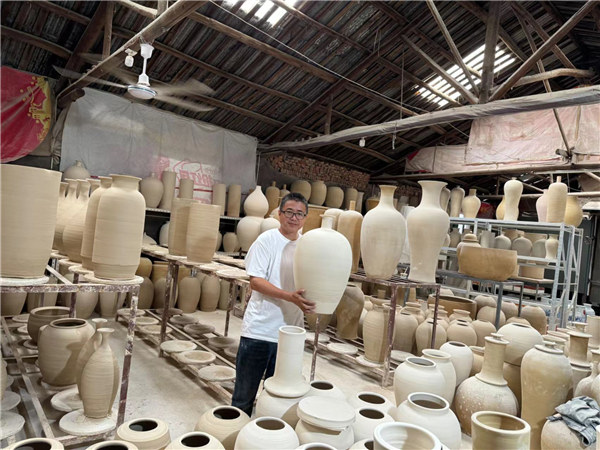

Craftspeople talk about pressure, satisfaction of continuing ancestors' work, Cai Hong reports in Jingdezhen.
Like most, Sun Lixin, the eldest child in the family-run businesses in Jingdezhen, east China's Jiangxi province, was born with a mission — succession.
The firstborn son was followed by a brother and a sister in a family that has made porcelain for four generations and was trained to inherit the family's ceramic making skills since he was a child.
His father, Sun Tongxin, has a masterly skill for blue and white painting on porcelain and was a trailblazer in splash ink painting on ceramic panels, blending the innovative contemporary high-temperature technique with the expressive methods of traditional Chinese blue and white ink painting. One of Sun Sr's pieces was collected by the Palace Museum in Beijing.
Ink color is one of the color painting decoration methods of ceramics. It refers to a kind of porcelain painting technique that uses thick or bright black as the main colorant to paint on ceramics, presenting a light-black ink effect. It has a strong literati charm and an artistic appeal, showing an elegant and simple, green and subtle aesthetic feeling.
"I grew up in an environment surrounded by ceramics and ceramists," Sun Lixin, 57, said.
He recalled that he did homework at the workshops where his parents worked when primary school finished. The three went home together after the adults got of work.
In 1976, then premier Zhou Enlai decreed the protection for traditional craftsmanship of porcelain production.
Thanks to the regulation, a group of teens in Jingdezhen was recruited by the local 10 state-owned porcelain factories to be trained in pottery-making techniques.
"Though being wet behind the ears, I was thrilled to be an apprentice in a state-owned factory," Sun Lixin said.
He was only 13.
"I liked to learn how to make ceramics, such as drawing, throwing and painting as many of my peers were also in the factory," he said.
Sun Lixin's teacher was his father, who was very strict with the naughty boy. Luckily, his peer apprentices, in his words, learned from their parents' friends, who were very friendly.
"I was always sniveling as my father bawled me out for doing things frolicsome with other children," Sun Lixin said. "One day, I ran away from home, saying to myself that I was damned if I was going to do pottery again."
However, he had no choice but to return home and continue his apprenticeship and his father had more teachers for the boy to sharpen his skill of Chinese painting.
Sun Lixin was a fast learner and became a skilled porcelain painter.